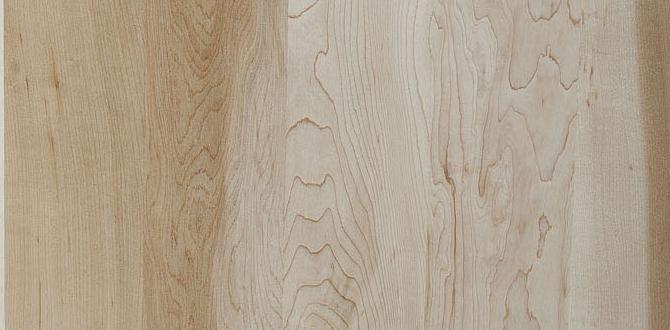Quick Summary
For effortless trim work, a 15-gauge or 16-gauge nailer is your best bet. These offer the perfect balance of holding power and minimal damage, sinking nails cleanly without splitting delicate trim pieces. They are ideal for crown molding, baseboards, and window casings, ensuring a professional finish for your DIY projects.
Hey there, DIY friends! Jack Shaffer, your Nailerguy, here. Ever look at beautiful trim work in someone’s home and think, “How did they do that so perfectly?” Well, a big part of that secret weapon is the right nail gun. Choosing the perfect nailer for trim can feel a bit tricky, with all the different gauges and options out there. But don’t you worry! I’m here to break it all down for you, making sure you pick the nailer that will help you achieve those stunning, professional-looking results without the headache. We’ll cover everything you need to know to get your trim projects done with confidence and ease.
Let’s dive in and find the perfect nailer for your next project!
Table of Contents
Choosing Your Trim Nailer: The Gauge Game
When you’re attaching delicate trim pieces like baseboards, crown molding, or window casings, the last thing you want is a nail gun that leaves a giant hole or splits the wood. That’s where nail gauge sizes come into play. Think of gauge like the thickness of a wire; a lower number means a thicker wire, and a higher number means a thinner wire. In the world of nail guns, this translates directly to the thickness of the nail being fired.
For trim work, we’re generally looking for nails that are strong enough to hold the trim securely in place but thin enough to disappear into the wood with minimal damage. This is why you’ll most often hear about 15-gauge and 16-gauge nailers for trim.
Understanding Nail Gauges for Trim
Let’s get a bit more specific about what those gauges mean for your trim projects:
- 15-Gauge Nailers (Angled Finish Nailers): These are fantastic for trim work. They fire nails that are slightly thicker than 16-gauge nails. This extra thickness gives them a bit more holding power, which can be beneficial for heavier trim pieces or if you want extra peace of mind that your trim won’t budge. Because they are angled, they can get into tight corners and fit between studs more easily, especially useful for crown molding. The holes they leave are still relatively small and easy to fill with wood putty or caulk.
- 16-Gauge Nailers (Straight Finish Nailers): These are the workhorses for a lot of trim jobs. They fire a thinner nail, which means they leave a smaller nail hole than a 15-gauge nailer. This makes them excellent for situations where appearance is paramount and you want the nail heads to be almost invisible after filling. They are great for delicate molding, picture frames, and any trim where a clean, unblemished surface is key.
- 18-Gauge Nailers: While not typically the first choice for structural trim like baseboards or crown molding, 18-gauge nailers are super useful for very thin, delicate decorative trim, paneling, or when you need to attach something without leaving much of a mark at all. The nails are quite thin, making them easy to hide.
- Other Gauges (e.g., 14-Gauge, Brad Nailers): You might see nailers with thicker nails (closer to framing nails) or very thin brad nailers. These are generally not ideal for attaching trim pieces to walls or framing because they either leave too large a hole (14-gauge) or don’t have enough holding power on their own for structural trim (brad nailers).
Why Gauge Matters for Trim
The gauge of the nail directly impacts:
- Holding Power: Thicker nails (lower gauge) offer more resistance and better holding power.
- Damage to Wood: Thinner nails (higher gauge) are less likely to split delicate wood or leave noticeable marks.
- Ease of Concealment: Smaller nail holes are easier to fill and thus hide for a cleaner finish.
The Best Nailer Types for Trim Work
When we talk about trim nailers, we’re usually referring to “finish nailers.” These are designed specifically for attaching trim molding and other decorative woodworking elements. Within the finish nailer family, you’ll find specific types that are optimized for different tasks, especially when it comes to angles.
Angled vs. Straight Finish Nailers
This is a crucial distinction when selecting your trim nailer:
- Angled Finish Nailers (Typically 15-Gauge): As I mentioned, these fire nails at an angle (usually 20 or 25 degrees). This angled head allows the nailer to get into tighter spaces. Think about installing crown molding – the angle allows you to drive the nail from the shoe molding up into the wall stud without hitting the ceiling or the wall directly in front of it. It also makes it easier to aim nails into studs when working in corners or around windows.
- Straight Finish Nailers (Typically 16 & 18-Gauge): These fire nails straight out, like a traditional hammer. They are excellent for areas where accessibility isn’t an issue and you want the absolute smallest possible nail hole. They are perfect for baseboards when you can easily access the studs directly behind them, or for any trim piece where you have a clear shot.
When to Choose Which Angle
Here’s a quick guide:
- For Crown Molding, Chair Rails, and Tight Corners: An angled finish nailer (15-gauge is ideal) is usually the best choice. It gives you the maneuverability you need.
- For Baseboards and Window Casings: Both angled and straight finish nailers can work well. If you’re working in tight situations or around window frames, an angled nailer can be more versatile. For straightforward baseboard installation on a long, open wall, a straight finish nailer might offer a slightly cleaner finish due to the smaller hole.
- For Delicate Decorative Trim: An 18-gauge straight finish nailer might be your go-to here, as it leaves the smallest mark.
Powering Your Trim Nailer: Pneumatic vs. Cordless
Once you’ve decided on gauge and angle, you’ll need to think about how your nailer is powered. The two main options for trim nailers are pneumatic (air-powered) and cordless (battery-powered).
Pneumatic (Air-Powered) Nailers
These are the traditional workhorses of the nail gun world. They require an air compressor and an air hose to operate.
Pros of Pneumatic Nailers:
- Lighter Tool Weight: The nailer itself is often lighter because the motor (compressor) is separate.
- Consistent Power: They deliver consistent, powerful nailing performance.
- Lower Initial Cost: Often, the nailer itself can be less expensive than a high-quality cordless model.
- No Batteries to Charge: As long as you have air, you can keep going.
Cons of Pneumatic Nailers:
- Requires Compressor and Hose: This adds bulk and limits your working area. You need to drag the hose around, which can be a tripping hazard and can snag.
- Noise: Air compressors can be quite loud.
- Setup Time: You need to connect the hose and let the compressor build up air pressure.
Cordless (Battery-Powered) Nailers
These have become incredibly popular for trim work due to their convenience. They use a battery to power a motor, which either drives a pneumatic mechanism internally or uses a spring-loaded system. Many modern cordless finish nailers are very effective.
Pros of Cordless Nailers:
- Ultimate Portability: No hoses or compressors! You can take them anywhere – up a ladder, into tight attics, or on a remote job site.
- Fast Setup: Just grab the nailer and go.
- Quiet Operation: Generally much quieter than pneumatic systems.
- Clean Work Area: No hoses to manage.
Cons of Cordless Nailers:
- Heavier Tool Weight: The battery and internal motor add weight to the tool itself.
- Battery Management: You need to keep batteries charged. Running out of juice mid-project can be frustrating.
- Higher Initial Cost: Cordless systems, especially those with multiple batteries, can be more expensive upfront.
- Power Sensitivity: Some very early or lower-end cordless models might not have the consistent power of a good pneumatic nailer, but this has improved dramatically.
The Nailer Guy’s Recommendation for Trim
For most DIYers tackling trim work, I highly recommend a 15-gauge angled finish nailer or a 16-gauge straight finish nailer. The choice between them often comes down to the nature of your trim work and personal preference.
If you’re doing a lot of crown molding, intricate casing, or working in many tight spots, lean towards the 15-gauge angled nailer. It offers the best versatility for those challenging angles.
If your projects are mostly straightforward baseboards on open walls, or you prioritize the absolute smallest nail hole possible, a 16-gauge straight finish nailer is a fantastic choice.
Power Source: Personally, I love the convenience of cordless for trim. The freedom to move around without a hose is a game-changer. However, if budget is a major concern and you already have a compressor, a pneumatic option is still a solid, reliable choice that will serve you incredibly well.
Key Features to Look for in a Trim Nailer
Beyond gauge and power source, here are some other important features to consider:
- Depth Adjustment: This is a must-have! It allows you to control how deep the nail is driven. You want to sink the nail just below the surface of the wood so you can fill it easily, but not so deep that you create a large, unsightly divot. Most good trim nailers have an easy-to-use dial for this.
- Jam Release Mechanism: Naysayers might say jams happen, but with a good nailer and proper use, they are rare. Still, when they do occur, you want a tool that makes clearing a jam quick and simple, often without needing extra tools.
- Maneuverability and Ergonomics: Since you’ll likely be holding the nailer for extended periods and in various positions, choose a tool that feels comfortable and balanced in your hand. Look for good grips and a tool that isn’t excessively heavy.
- No-Mar Tip: Many trim nailers come with a rubber or plastic tip on the nose. This prevents marring or denting the surface of your delicate trim material when you fire the nail.
- Swiveling Belt Hook: Handy for keeping your nailer accessible when you’re not actively using it, especially on a ladder or when moving around a job site.
- Tool-Free Depth Adjustment: While most have this, some are easier to use than others.
- Integrated LED Light: Can be helpful for illuminating your work area, especially in dimly lit spaces.
Essential Accessories for Trim Nailer Success
You’ve got your nailer, but what else do you need to make your trim project a success?
- The Right Nails: This might seem obvious, but using the correct gauge and length is crucial. For trim, you’ll typically use nails between 1-1/4 inches and 2-1/2 inches long, depending on the thickness of your trim and the framing behind it. Always check your nailer’s specifications for compatible nail sizes.
- Air Compressor (if pneumatic): If you go pneumatic, you’ll need a compressor. For trim work, a small, portable compressor (around 1-2 gallons) is often sufficient, especially if you’re not firing nails at an incredibly rapid rate. Look for one that can maintain consistent pressure.
- Air Hose and Fittings (if pneumatic): A lightweight, flexible air hose (around 25-50 feet) is ideal for trim work. Don’t forget the quick-connect fittings for easy attachment and detachment from the nailer and compressor.
- Safety Glasses: Non-negotiable! Always protect your eyes. Flying debris or a ricochet can cause serious injury.
- Hearing Protection: Especially important if using a pneumatic nailer and compressor.
- Wood Filler/Putty: Essential for filling nail holes for a smooth, professional finish.
- Caulk: For filling small gaps between trim and walls/ceilings.
- Measuring Tape and Pencil: For accurate measurements and marking.
- Miter Saw: For cutting your trim pieces accurately at the correct angles (mitered corners).
Nailer Comparison Table
To help you visualize the differences, here’s a quick comparison of the most common trim nailer gauges:
| Gauge | Nail Diameter | Common Uses for Trim | Pros | Cons |
|---|---|---|---|---|
| 15-Gauge | ~0.072 inches | Crown molding, baseboards, window/door casings, chair rails. Excellent for angled nailing. | Good holding power, minimal splitting, angled head excels in tight spots. | Slightly larger hole than 16-gauge, usually angled (less versatile for some flat-plane work). |
| 16-Gauge | ~0.0625 inches | Baseboards, window/door casings, paneling, decorative trim. Versatile for straight nailing. | Smallest nail hole for a nearly invisible finish, good holding power for most trim, often straight-headed. | Can split very delicate wood if not careful, less holding power than 15-gauge for very heavy trim. |
| 18-Gauge | ~0.0475 inches | Very thin decorative molding, bead board, delicate trim, picture frames. | Leaves the smallest mark, ideal for very fine detail work. | Limited holding power for structural trim, can bend easily. |
Safety First!
Nail guns are powerful tools, and safety should always be your top priority. Here are some fundamental safety tips:
- Always wear safety glasses. This is the absolute most important rule.
- Never point the nailer at yourself or anyone else. Treat it like a loaded firearm.
- Keep your fingers away from the trigger and the firing nose.
- Ensure the workpiece is stable. Place the nailer firmly against the surface before firing.
- Depress the safety contact tip fully before pulling the trigger. Most nailers have a safety mechanism that requires the tip to be pressed against the wood for it to fire.
- Never disable safety features.
- Disconnect the power source (unplug from air or remove battery) when changing nails, performing maintenance, or leaving the tool unattended.
- Read your tool’s manual. Every nailer is a little different, and the manual contains vital operating and safety information. For more detailed safety guidelines, the Occupational Safety and Health Administration (OSHA) provides extensive resources on power tool safety, including nail guns, which you can find on their website, OSHA.gov.
Step-by-Step: Using Your Trim Nailer for Effortless Trim Installation
Okay, you’ve got your nailer, you’ve got your trim, and you’re ready to go! Here’s how to install trim like a pro:
Step 1: Prepare Your Workspace and Tools
Ensure you have your nailer, nails, safety gear, measuring tape, pencil, and miter saw ready. Clear the area where you’ll be working.
Step 2: Set Up Your Nailer
Pneumatic: Connect your air hose to the nailer and the compressor. Set your compressor to the recommended PSI for your nailer (usually found in the manual for both the nailer and compressor). Make sure your air hose is routed so it won’t be a tripping hazard or snag on anything.
Cordless: Insert a fully charged battery. Ensure you have the correct size nails loaded in the magazine.
Step 3: Test Fire and Adjust Depth
Find a scrap piece of the same trim material you’ll be using. Aim the nailer at the scrap wood and fire a nail. Check how deep it went. If it’s too high, adjust your nailer’s depth setting to sink it deeper. If it punched too far into the wood, adjust to drive it shallower. You’re looking




